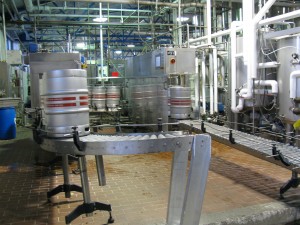
Packaging hall at Victory Brewing Company
The conditioned, clear (“bright”) beer is transferred to a bright beer tank. Carbon dioxide is added to give the expected effervescence.
In a brew pub, the beer may be run directly from the bright beer tank to a serving valve called s tap. In breweries that serve an outside clientele, the beer is put into metal barrels called kegs or casks for sale to bars, or into small packs. Kegs have a single opening with a tube called the spear leading to the bottom. A standard size keg in the United States holds 15.5 US gallons (58.7 liters). European kegs are often 50 L. Casks have a side opening for filling and an end opening for serving.
In modern times, most beer is packaged in small packs, which can be metal cans or glass bottles containing individual servings.
Often the beer is pasteurized to kill microbes or filtered to remove them before packaging.
This topic is covered in The Chemistry of Beer: The Science in the Suds, Chapter 14.